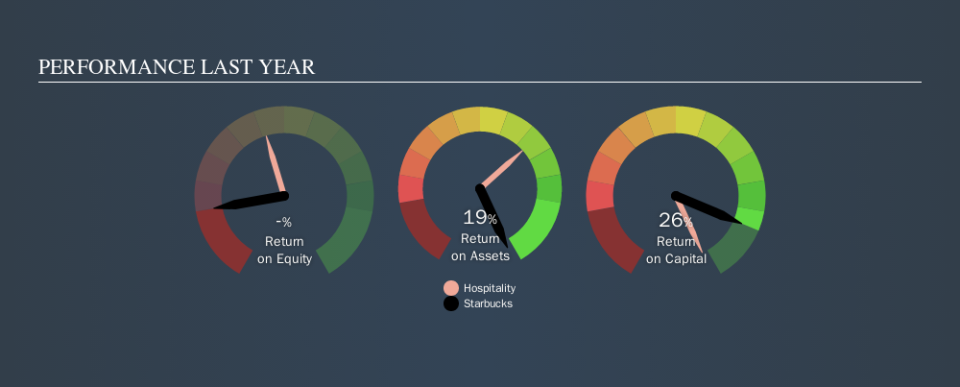A Close Look At Starbucks Corporation’s (NASDAQ:SBUX) 26% ROCE

Today we'll evaluate Starbucks Corporation (NASDAQ:SBUX) to determine whether it could have potential as an investment idea. Specifically, we'll consider its Return On Capital Employed (ROCE), since that will give us an insight into how efficiently the business can generate profits from the capital it requires.
First up, we'll look at what ROCE is and how we calculate it. Second, we'll look at its ROCE compared to similar companies. Last but not least, we'll look at what impact its current liabilities have on its ROCE.
What is Return On Capital Employed (ROCE)?
ROCE is a metric for evaluating how much pre-tax income (in percentage terms) a company earns on the capital invested in its business. Generally speaking a higher ROCE is better. Ultimately, it is a useful but imperfect metric. Renowned investment researcher Michael Mauboussin has suggested that a high ROCE can indicate that 'one dollar invested in the company generates value of more than one dollar'.
So, How Do We Calculate ROCE?
Analysts use this formula to calculate return on capital employed:
Return on Capital Employed = Earnings Before Interest and Tax (EBIT) ÷ (Total Assets - Current Liabilities)
Or for Starbucks:
0.26 = US$3.8b ÷ (US$21b - US$5.9b) (Based on the trailing twelve months to June 2019.)
Therefore, Starbucks has an ROCE of 26%.
Check out our latest analysis for Starbucks
Does Starbucks Have A Good ROCE?
ROCE is commonly used for comparing the performance of similar businesses. In our analysis, Starbucks's ROCE is meaningfully higher than the 8.9% average in the Hospitality industry. I think that's good to see, since it implies the company is better than other companies at making the most of its capital. Putting aside its position relative to its industry for now, in absolute terms, Starbucks's ROCE is currently very good.
Starbucks's current ROCE of 26% is lower than 3 years ago, when the company reported a 38% ROCE. So investors might consider if it has had issues recently. You can click on the image below to see (in greater detail) how Starbucks's past growth compares to other companies.
When considering ROCE, bear in mind that it reflects the past and does not necessarily predict the future. ROCE can be deceptive for cyclical businesses, as returns can look incredible in boom times, and terribly low in downturns. ROCE is, after all, simply a snap shot of a single year. Since the future is so important for investors, you should check out our free report on analyst forecasts for Starbucks.
What Are Current Liabilities, And How Do They Affect Starbucks's ROCE?
Current liabilities include invoices, such as supplier payments, short-term debt, or a tax bill, that need to be paid within 12 months. The ROCE equation subtracts current liabilities from capital employed, so a company with a lot of current liabilities appears to have less capital employed, and a higher ROCE than otherwise. To counteract this, we check if a company has high current liabilities, relative to its total assets.
Starbucks has total liabilities of US$5.9b and total assets of US$21b. As a result, its current liabilities are equal to approximately 28% of its total assets. This is quite a low level of current liabilities which would not greatly boost the already high ROCE.
What We Can Learn From Starbucks's ROCE
This is good to see, and with such a high ROCE, Starbucks may be worth a closer look. There might be better investments than Starbucks out there, but you will have to work hard to find them . These promising businesses with rapidly growing earnings might be right up your alley.
For those who like to find winning investments this free list of growing companies with recent insider purchasing, could be just the ticket.
We aim to bring you long-term focused research analysis driven by fundamental data. Note that our analysis may not factor in the latest price-sensitive company announcements or qualitative material.
If you spot an error that warrants correction, please contact the editor at editorial-team@simplywallst.com. This article by Simply Wall St is general in nature. It does not constitute a recommendation to buy or sell any stock, and does not take account of your objectives, or your financial situation. Simply Wall St has no position in the stocks mentioned. Thank you for reading.

 Yahoo Finance
Yahoo Finance 
